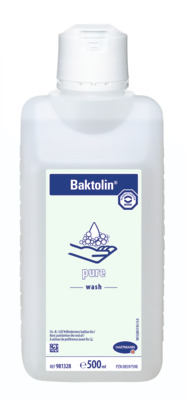Reports & expert advice
Breaking the taboo around urinary incontinence
Urinary leakage is not a topic we often talk about. Yet it is a problem that affects many women, especially during menopause and postmenopause stage. Fortunately, there are many things you can do about it: From exercises to nutrition strategies and avoidable toilet habits.
MoliCare® teamed up with inspiring women like the registered nutritionist Ms. Emma Bardwell who offer an emotional and professional support for women experiencing urinary leakage. In this article, she shared her tips to manage bladder weakness.

There are many ways to manage your bladder weakness and live the life you are used to.
Do you leak when you laugh?
If you answered yes, you’re not alone. According to research, 40 percent of women in the UK1 have some kind of urinary incontinence. In reality this figure is likely to be much higher because women are often embarrassed by symptoms and don’t report them to their GP. There’s still, unfortunately, a ‘this is part of being a woman’ mentality around leakage, which prevents women getting help.
Urinary leakage can happen to any woman at any age, but it’s particularly common around perimenopause and menopause, mainly due to depleting levels of sex hormones2. As our oestrogen levels drop, the muscles that support our pelvic floor can weaken and the lining of the bladder and urethra can become thinner and more sensitive. Women commonly exercise less during the menopause transition and experience increased weight and abdominal fat, which when combined can cause an overall weakening in pelvic floor muscles.
The good news, however, is that just because urinary leakage is common, it doesn’t mean you have to put up with it. Here’s what you need to know.
The topics in this article:
Blog.Share
The different types of incontinence
There are a few different types of incontinence. Knowing which one or ones you have can really help you to pinpoint how to talk about and address your symptoms.
Stress incontinence
Urge incontinence
Overactive bladder
Mixed incontinence
Power up your pelvic floor
The first port of call for preventing leaks is to improve the function and strength of your pelvic floor muscles. It’s free, simple (once you know how!), has no side effects and helps with urge and stress incontinence.
A quick step by step guide:
- Some people find it easier to locate the right muscles if they sit on the arm of a chair or any hard surface. Lean slightly forward with your vulval area in contact with the hard surface.
- Relax your pelvic floor muscles by taking a deep breath in and, as you exhale, letting everything relax.
- Take another breath in and as you exhale think about pulling the vulva and back passage up and away from the surface you’re sitting on.
- Take another breath in and as you exhale, let everything relax again. This ‘letting go’ is just as important as the squeezing step, so don’t be tempted to miss it out.
- Once you feel you’ve got to grips with your pelvic floor exercises, try drawing up, squeezing and lifting for a count of five (aim to build up to a count of 10). Let go gently and count to five. Repeat the movement again, five times.
- The NHS advise doing pelvic floor exercises three times a day3, but even doing a couple of lifts every now and then throughout the day is helpful. Once you’ve mastered pelvic floor exercises sitting down, you can progress to doing them standing up.
- Once a day, do a series of ten short sharp contractions. These are done in a rhythmic pattern of squeeze, let go, squeeze, let go.
- If you need motivation to keep going, using tools and apps can be a great help. A good option is the award winning Squeezy App4, but if you think that you can’t contract or relax your pelvic floor muscles or you’re struggling to find them, please seek help from a women’s health physio or incontinence specialist. There are lots around.
- Incontinence products have better absorption capacity than period pads. Order your free MoliCare sample with the promocode FREEDELIVERY10.

Shop for Comfortable Incontinence Solutions
Discover how our incontinence pads can make your life comfortable and help you live with freedom and confidence.
Build muscles everywhere
Increasing your overall cardiovascular fitness and strength around your glutes (buttocks), adductors (inner thighs) and abdominal (belly) region can have significantly positive effects on your pelvic floor strength5. Interestingly a study in women showed a link between hand grip strength and the likelihood of having stress incontinence, so being physically fit is definitely a goal worth pursuing. Opt for low impact activities that allow you to build muscle mass. Changes in overall strength and conditioning take about six to eight weeks so do try to be patient and don’t give up if you don’t notice improvements straight away.
My favourite tip for stress incontinence
This is what I call the ‘pre-sneeze squeeze’ and it works a treat! When you know you’re going to cough or sneeze, activate your pelvic floor quickly beforehand (using the method outlined in the step by step guide above) to help withstand the pressure. Lift and hold your pelvic floor muscles to brace for impact, then relax once it has passed.
1. Liquids
Toilet habits to avoid
- Don’t push your urine out. You don’t need to bear down or push your wee out with force when you urinate. Take your time, get comfy, relax and let go.
- Don’t hover! Many women do this when they’re in public toilets. It actually activates the pelvic floor muscles which prevents you from emptying your bladder completely.
- Don’t go to the toilet ‘just in case’ as it can make your bladder less responsive and more overactive.
Trust the process
There are lots of femtech related gadgets and devices on the market, from vaginal weights to electronic toners to lasers. Doing pelvic floor exercises in conjunction with a gadget can be motivating – and motivation is key! However, this doesn’t mean that doing your pelvic floor exercises alone isn’t enough, it absolutely is. We are all different. Do whatever works for you and encourages you to be consistent. Essentially, we all want the same result: a stronger pelvic floor.
What if pelvic floor exercises don’t work?
Your doctor can prescribe certain antimuscarinic medications that help although they’re not advisable long term. A common one is oxybutynin. These are usually taken as a tablet that you take two or three times a day, although oxybutynin also comes as a patch that you place on your skin twice a week. You will usually start taking a low dose to minimise any possible side effects. The dose can be increased until the medicine is effective. There are possible side effects of that include dry mouth, constipation, blurred vision and extreme tiredness.
Interestingly botox has also been approved for urge incontinence in the last few years. It has very good success rates with 30% reporting complete dryness and 80% significant improvement. It works by relaxing the muscles in the bladder and decreases urgency and frequency. Essentially it gives you more time to get to the toilet. The procedure would need to be performed twice a year by a urologist and is pretty painless.
And finally, localised oestrogen has been shown to really strengthen the urethra and bladder prevents urethral prolapse and helps to support the vaginal tissues. It can be particularly helpful with urge incontinence and overactive bladder issues, with lots of women saying it stops them getting up so often in the night to go to the toilet.
Peace of mind
For the ultimate peace of mind until you get your pelvic floor back in shape, a discreet Molicare® Premium Lady Pad that locks in urine and keeps you dry and comfortable is a must-have. Whether you leak a little or need extra reassurance Molicare has plenty of options. All MoliCare Pads, Pull-up Pants, All-in-one Slips as well as Skin Care products are designed specifically for incontinence. This is important as period products don’t have the same absorption profile or wicking capacity as incontinence pads, so can irritate and cause discomfort. Molicare Premium Lady incontinence pads have a absorbent core to retain urine, anti-leakage cuffs for extra insurance6 and neutralise any odour.
For 20% off your entire first order use EMMA2022 during your order.
Get 20% off on MoliCare® Premium
Simply enter the code EMMA2022 when placing your order and receive a 20% off your entire first order.
About the author - Emma Bardwell
Incontinence and bladder weakness are often a common consequence of the hormonal change that occurs during the perimenopause. For many women, going through this phase can feel like their world is being turned upside down. As a registered nutrionist and a women´s health specialist, Emma Bardwell is here to guide you through the perimenopause – by sharing evidence-based advice as well as her own personal insights.
Emma´s interest in the topic began when she started experiencing perimenopause symptoms herself more than 10 years ago. Because she quickly noticed there just wasn’t enough evidence-based nutrition information around, she soon began to educate herself and, in the process, became an expert on the topic. Today, Emma blends nutritional science, diet therapy and behaviour change on her website and her Instagram page. In addition to her recently published book “The Perimenopause Solution”, she also hosts workshops and regularly appears on podcasts.

1 https://www.ncbi.nlm.nih.gov/pmc/articles/PMC1476070/
2 https://www.menopause.org/for-women/sexual-health-menopause-online/causes-of-sexual-problems/urinary-incontinence
3 https://www.nhs.uk/planners/pregnancycareplanner/documents/bandbf_pelvic_floor_women.pdf
4 https://squeezyapp.com
5 https://www.nafc.org/step-4-start-implementing-exercises
6 Except for MoliCare Premium Lady Pad 0.5, 1, 1.5 Drops
Always safe, always confident - with Molicare®
MoliCare® from HARTMANN provides reliable leakage protection and maintains healthy skin with pH-neutral value
for effective incontinence management. For light, moderate or severe incontinence.
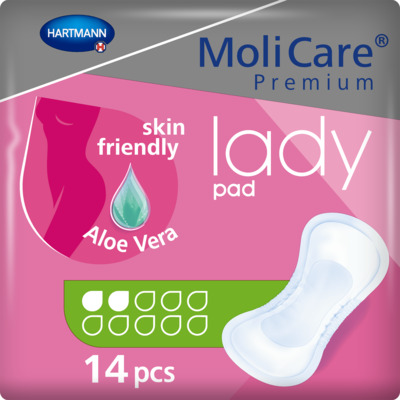
MoliCare® Premium Lady Pad 2 Drops
<h2>Skin Friendly Pant Liners</h2> <p>For women that experience slight incontinence and bladder weakness, across different age groups, it can be a challenge to find the right bladder weakness product that is easy to apply and wear without the worry of potential leakages. Fortunately, we understand this approach, hence why we are happy to offer our MoliCare® Premium Lady Pad 2 drops, that is skin-friendly, Aloe Vera applied, and comes with 14 liners per bag.</p> <h2>Slim and discreet liners</h2> <p>Whether dealing with stress incontinence or urge incontinence, these panty liners offer a discreet and easy solution on the go. Simply place the pad in your underwear and secure it with the adhesive strip for all-round protection. Available in different absorbency levels, MoliCare® bladder weakness products cater to all levels of bladder weakness, ensuring secure care.</p> <h2>Control Bladder Weakness</h2> <p>Enjoy the benefits of these body-shaped absorbent panty liners, designed for women with bladder weakness. The pads offer discreet, reliable protection with features including odour control and fast absorption.</p> <p>With a wide adhesive strip, you can comfortably fix the pad in your regular underwear, providing secure and comfortable fixation. The pads are skin-friendly, featuring soft, breathable materials, including foam cuffs, and a top sheet treated with Aloe Vera.</p> <p>Keeping your skin healthy is a priority, which is why MoliCare® Premium Lady Pads have a skin-neutral pH value of 5.5 and an antibacterial finish. They are also dermatologically tested, offering peace of mind.</p> <h2>Buy pant liners online</h2> <p>Never worry about running out with our convenient order service and fast delivery direct to your door. Enjoy free shipping on orders over £50.</p> <p>If you need assistance, our professional customer service team is here to support you in choosing the right product. Reach out to us today at 0800 028 9470 and experience the comfort and reliability of MoliCare® Premium Lady Pads.</p>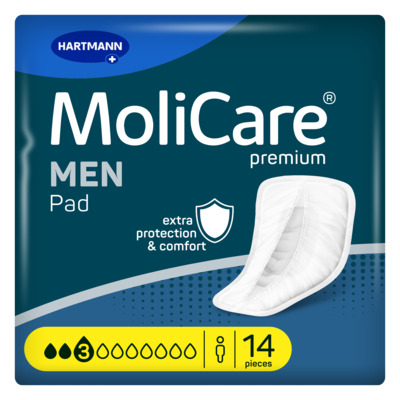
MoliCare® Premium Men Pad 3 Drops (ISO 441ml)
<p><strong>Reliable and discreet incontinence pads for men with an instant-dry feeling</strong></p> <p>Bladder weakness is difficult to live with, the last thing you want to worry about is incontinence protection. That’s why our best-ever MoliCare® premium MEN Pad 3 drops offer an <strong>all-round protection</strong> that keeps everything dry and comfortably in place while fitting discreetly in your regular underwear.</p> <p>The incontinence pad for men quickly <strong>removes urine from the surface up to 86 %* faster than before</strong> and neutralises unpleasant odours to leave you feeling instantly dry and in control thanks to the new <strong>MoliCare SkinGuard</strong>®<strong> Absorbent Core Technology</strong>. This skin-friendly technology not only helps you feel up to 90 %* drier than previous MoliCare® premium<strong> </strong>MEN pads, it also helps to maintain healthy skin and preventing irritation.</p> <p><strong>Engineered for the male anatomy</strong> and dermatologically tested for maximum skin compatibility, these male urinary pads do not contain colour, perfume or latex making them environmentally friendly too.</p> <p>*Compared to last generation</p>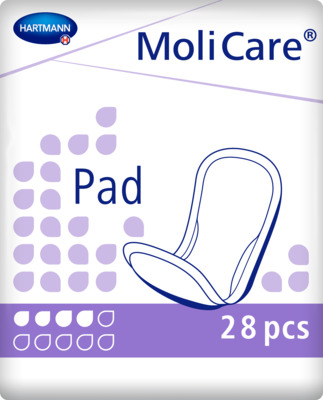
MoliCare® Pad 4 Drops
<h2>Handy MoliCare incontinence pads to carry on the go</h2> <p>Our MoliCare® Pad 4 Drops are an essential product for those experiencing slight incontinence, allowing you to regain control and live your busy and active life without the interference of bladder weakness. Designed for both men and women, this incontinence pad for men and women offers exceptional dryness and protection, ensuring your comfort and confidence.</p> <h2>‘Barely There’ Reassurance and Reliability</h2> <p>The MoliCare® Pad 4 Drops are slimline, discreet, and adjusted to fit your body seamlessly. It fixes securely inside your underwear, providing a ‘barely there’ comfort feel. With its soft and skin-kind fabric, along with a wide adhesive fixing strip on the backsheet, you can go about your day with the assurance of being protected against leakages.</p> <p>The absorbent core effectively prevents your skin from becoming too moist, while the elastic anti-leak edging adds an extra layer of security and peace of mind. Say goodbye to any worries about odours, as the MoliCare® Pad 4 Drops also neutralises odours to keep you fresh and confident throughout the day. Don't let incontinence hold you back from living life to the fullest.</p> <p>Ordering your MoliCare® Pad 4 Drops is hassle-free, as we offer fast delivery direct to your door. With our price match promise, you can trust that you're getting the best value for your money. Plus, enjoy free delivery on all orders over £50.</p> <p>If you need assistance in finding the perfect incontinence product for your needs, our friendly customer care team is here to help. Don't hesitate to reach out to us at 0800 028 9470. Take control of your life with the reliable protection and comfort of the MoliCare® Pad, alongside other <a href="https://www.hartmanndirect.co.uk/incontinence-products/incontinence-pads" style="color:#0563c1; text-decoration:underline">incontinence pads</a>.</p>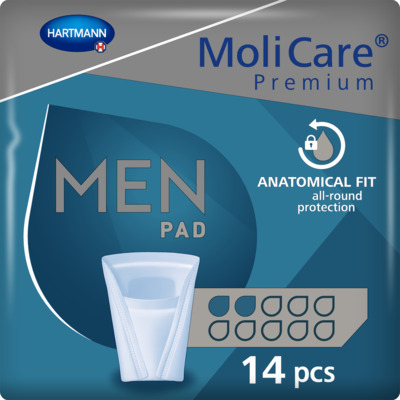
MoliCare® Premium Men Pad 2 Drops
<h2>Superior Comfort and Protection for men</h2> <p>This product is part of our mens range of incontinence pads and pouches for men handling slight incontinence. </p> <p>It is a one size fits all with the MoliCare® Premium Men Pad 2 drops, designed to keep the skin fresh and dry. The anatomical fit of the pad allows for all-round protection. These specially designed pads offer superior comfort, security, and protection, allowing men to confidently carry on with their daily activities without worries.</p> <p>Still unsure whether to choose this product? Check out these additional features:<br /> </p> <ol> <li>Tailored for Men: MoliCare® Premium Men Pad 2 Drops is specifically designed to cater to the unique anatomy and needs of men experiencing bladder weakness. The pouch shape and comfortable fit ensure maximum coverage and security.</li> <li>Reliable Absorption: The pouch's absorbent core quickly and effectively locks away moisture, keeping the skin dry and preventing any discomfort or irritation.</li> <li>Odour Control: With built-in odour neutralisers, MoliCare® Premium Men Pad 2 Drops helps to maintain a fresh and odour-free environment, boosting confidence and ensuring discretion.</li> <li>Soft and Gentle: The soft topsheet is gentle on the skin, promoting skin health and preventing any irritation or chafing.</li> <li>Discreet and Thin Design: These pads are slim and discreet, allowing men to wear them under regular underwear without any bulkiness or discomfort.</li> <li>Ideal for Light Bladder Weakness: Whether it's occasional leaks or mild incontinence, these pads provide reliable protection, giving men the confidence they need to face each day with ease.</li> <li>Discreet Packaging: The pads are individually wrapped for convenience and discretion, making them easy to carry and use discreetly when needed.</li> </ol>